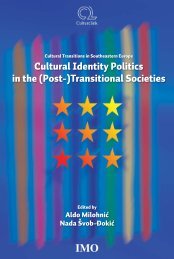D:\Documents and Settings\Ana\My Documents\Biserka-knjiga ...
D:\Documents and Settings\Ana\My Documents\Biserka-knjiga ...
D:\Documents and Settings\Ana\My Documents\Biserka-knjiga ...
Create successful ePaper yourself
Turn your PDF publications into a flip-book with our unique Google optimized e-Paper software.
Digital Culture: The Changing Dynamics<br />
Similarly, looking at specific branches of cultural production – the music industry<br />
as part of the creative industries of the region – Table 5 below shows us data on<br />
domestic music piracy levels in 2004.<br />
Table 5: Domestic music piracy levels in 2004*<br />
Country Over 50% 25-50% 10-24% Less than 10%<br />
Europe Bulgaria Croatia Belgium Austria<br />
Czech Republic Cyprus Finl<strong>and</strong> Denmark<br />
Estonia Hungary Netherl<strong>and</strong>s France<br />
Greece Italy Slovenia Germany<br />
Latvia Pol<strong>and</strong> Spain Icel<strong>and</strong><br />
Lithuania Portugal Irel<strong>and</strong><br />
Romania Slovakia Norway<br />
Russia Sweden<br />
Serbia/Montenegro Switzerl<strong>and</strong><br />
Turkey UK<br />
Ukraine<br />
Domestic music piracy levels are calculated as pirate units divided by legal units plus pirate units.<br />
*Source: IFPI, 2008 .<br />
Although the table above does not give us data on all the countries of the region,<br />
one can note the trend, which shows that the majority of the SEE countries presented<br />
here have a high domestic music piracy rate of over 50%, while only Croatia has a<br />
rate lower than 50%.<br />
Piracy as defined previously (organized piracy for commercial purposes) is thus<br />
very much present in the SEE region according to the available data presented above.<br />
On the other h<strong>and</strong>, what should be mentioned are the new models of digital<br />
distribution, promotion <strong>and</strong> exchange, primarily p2p, that are br<strong>and</strong>ed as piracy. The<br />
distinction has to be made. In this regard, we would agree with Lawrence Lessig<br />
(2004: 66) when he stresses “…even if some piracy is plainly wrong, not all ‘piracy’<br />
is”. Lessig stresses that there are questions raised by the p2p sharing as the latest<br />
“piracy” concern, but we need to underst<strong>and</strong> it better before defining it as piracy. “For<br />
(1) like the original Hollywood, p2p sharing escapes an overly controlling industry;<br />
<strong>and</strong> (2) like the original recording industry, it simply exploits a new way to distribute<br />
content; but (3) unlike cable TV, no one is selling the content that is shared on p2p<br />
services. These differences distinguish p2p sharing from true piracy. They should<br />
push us to find a way to protect artists while enabling this sharing to survive” (Lessig,<br />
80



